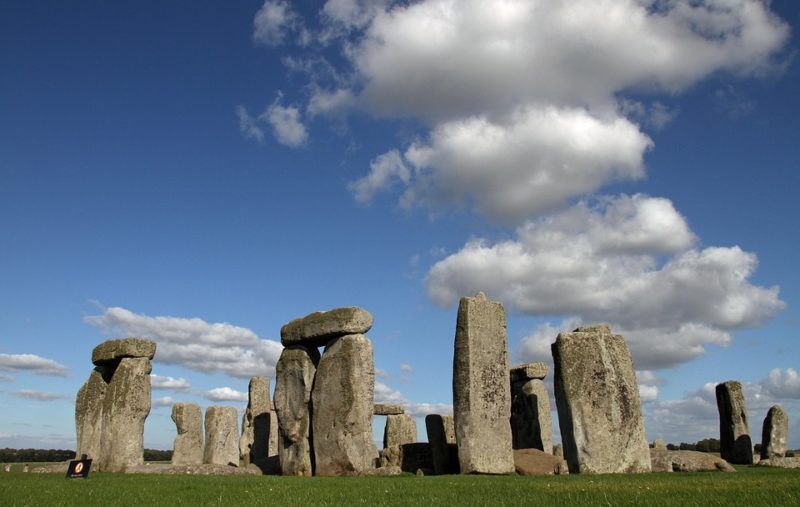
The northern hemisphere’s summer solstice—and the winter solstice south of the equator—happens this year on June 21, 2017 at 4:24 UTC (that’s 11:24 p.m. CDT in North America on June 20). Tens of thousands of revelers are expected to congregate at Stonehenge, a surprising number of them in white robes claiming—perhaps quite seriously—to be modern-day druids. There may be no better place in the world to witness the year’s first rays of summer, and the longest day of the year, than at this mysterious ring of stones amidst a party atmosphere.
Missing the twice yearly phenomenon? On any given day Britain’s best-known prehistoric site is still as magical, mystical, and mysterious as it was probably always meant to be—but only if you catch it between tour bus caravans. No one knows for sure the reason for Stonehenge, although it is fairly certain that ancient Neolithic and Bronze Age peoples built this stunning collection of artfully placed rocks over a very long period, then used the site for rituals or ceremonies pertaining to the sun and perhaps also as a calendar. In the 17th century, the widely held view that the circle was somehow connected to the Celtic druids took hold and has never died, even though it has since been proved that Stonehenge predates the priestly cult by at least 1,500 years and probably more. More than one million visitors from around the world visit Stonehenge every year.
 The massive trilithons—two upright stones with a lintel across the top—were assembled some 4,000 years ago. Some of the standing stones weigh up to 50 tons, and experts estimate that to move each one into position took more than 1,000 men. Scholars disagree about where the stones came from (some say southwest Wales) and how they got to the windswept Salisbury Plain. Modern researchers believe they were to be put together in three distinct stages (two of which were never completed), in alignments made possible by sophisticated builders with a knowledge of astronomy, mathematics, and engineering unparalleled anywhere in Europe at that time. Today, thousands of visitors gravitate here, especially for the summer and winter solstice, including many modern-day druids and followers of other pagan religions.
The massive trilithons—two upright stones with a lintel across the top—were assembled some 4,000 years ago. Some of the standing stones weigh up to 50 tons, and experts estimate that to move each one into position took more than 1,000 men. Scholars disagree about where the stones came from (some say southwest Wales) and how they got to the windswept Salisbury Plain. Modern researchers believe they were to be put together in three distinct stages (two of which were never completed), in alignments made possible by sophisticated builders with a knowledge of astronomy, mathematics, and engineering unparalleled anywhere in Europe at that time. Today, thousands of visitors gravitate here, especially for the summer and winter solstice, including many modern-day druids and followers of other pagan religions.
Not as famous as Stonehenge but more powerful for their simplicity, the nearby Avebury Stone Circles, some 20 miles north, were erected 500 years before Stonehenge was completed. Uncrowded and more accessible, they consist of circles of 100 massive stones.
Where: 85 miles/137 km southwest of London. Visitor info. Best times: early morning or late afternoon to avoid crowds; summer and winter solstices (usually sunrise on Jun 21 and Dec 22), and spring and fall equinoxes (the halfway points between the solstices).
 About the Book:
About the Book:
The world’s bestselling travel book is back in a more informative, more experiential, more budget-friendly full-color edition. A #1 New York Times bestseller, 1,000 Places reinvented the idea of travel book as both wish list and practical guide. As Newsweek wrote, it “tells you what’s beautiful, what’s fun, and what’s just unforgettable—everywhere on earth.” And now the best is better. There are 600 full-color photographs. Over 200 entirely new entries, including visits to 28 countries like Lebanon, Croatia, Estonia, and Nicaragua, that were not in the original edition. There is an emphasis on experiences: an entry covers not just Positano or Ravello, but the full 30-mile stretch along the Amalfi Coast.
Every entry from the original edition has been readdressed, rewritten, and made fuller, with more suggestions for places to stay, restaurants to visit, and festivals to check out. And throughout, the book is more budget-conscious, with starred restaurants and historic hotels such as the Ritz, but also moderately priced gems that don’t compromise on atmosphere or charm.
The world is calling. Time to answer.
Buy the Book
Amazon | B&N | Indiebound | Workman





No Comments